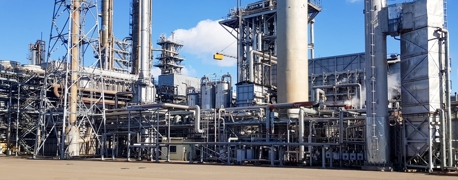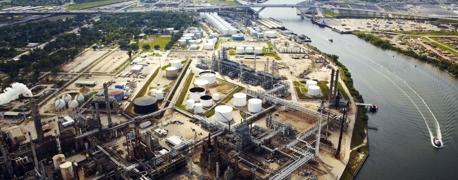Parker Lord Explosion Raises Safety & Environmental Concerns

A massive industrial fire at Parker Lord Corporation in Saegertown, Pennsylvania, led to a powerful explosion on February 9, 2025, injuring at least 13 people and prompting an immediate shelter-in-place advisory for local residents. Although no fatalities have been reported, the incident left both the community and state officials questioning the adequacy of existing safeguards, the cause of the explosion, and the broader regulatory framework governing similar industrial operations.
Largest Specialty Chemicals Plant in Lord Portfolio
Located along Route 198, Parker Lord’s Saegertown facility is the company’s largest specialty chemicals, adhesives, and coatings manufacturing plant, employing more than 235 workers. The site completed an $80 million expansion in 2023, adding 75,000 square feet to its existing 250,000-square-foot operation.
According to the company’s public statements, materials produced in Saegertown include acrylic, urethane, and epoxy adhesives—as well as Chemlok® rubber-to-substrate bonding agents—used globally by the automotive, aerospace, and oil and gas industries.
What Happened at the Parker Lord Plant
Emergency alarms at the facility first sounded around 10:30 a.m., alerting local fire departments to what was initially reported as a standard industrial fire. However, as firefighters from Saegertown and neighboring communities attempted to contain the flames, an explosion rocked the plant, hurling debris hundreds of yards.
The explosion left significant structural damage and ignited a larger fire that took hours to control. In total, 13 individuals—seven plant employees, five Saegertown firefighters, and one Edinboro firefighter—were transported to local hospitals, including Meadville Medical Center and UPMC Hamot in Erie.
Officials temporarily enacted a shelter-in-place, instructing residents to close windows and doors while monitoring local alerts. The order was lifted later that afternoon once air quality readings suggested no imminent health threats.
What Chemicals Were Involved?
While the specific chemicals involved in the explosion have not been publicly confirmed, Parker Lord’s Saegertown site is known for manufacturing a variety of adhesives, coatings, and specialty materials.
These often include:
- Acrylic, Urethane & Epoxy Adhesives: Commonly used in automobile manufacturing, aerospace components, and other industrial applications.
- Rubber-to-Substrate Bonding Agents (Chemlok®): Specialized chemical products for sealing and bonding rubber parts to metal or plastic surfaces.
- Intermediate Chemicals & Coatings Products: Supplied globally to industrial customers for a range of applications.
A water and air quality assessment is underway to determine if any hazardous byproducts were released. According to Saegertown Borough officials, runoff water used to combat the blaze was contained in designated retention ponds on Parker Lord property and removed by an approved contractor.
Regulatory Oversight: DEP & OSHA Investigations
Pennsylvania Department of Environmental Protection (DEP)
The Pennsylvania DEP responded immediately, focusing its initial investigation on areas downwind of the plant to identify possible contamination. While no major environmental impacts have been confirmed, the agency is evaluating local water sources—including nearby streams and the Saegertown municipal water system—to verify that any leaked chemicals did not enter the public supply.
Occupational Safety & Health Administration (OSHA)
With 13 injuries reported, OSHA has launched its own inquiry to assess whether workplace safety standards were adequately followed.
Investigators will likely review:
- Maintenance and Inspection Records: Were equipment and facilities regularly checked and serviced?
- Safety Protocols and Employee Training: Did the company implement standard operating procedures for handling volatile chemicals and controlling fires?
- Emergency Response Plans: Did Parker Lord have an established plan, and was it executed properly when the alarm sounded?
OSHA investigations can lead to citations, fines, or other sanctions if regulators determine that lax safety protocols contributed to the blast.
What Caused the Parker Lord Fire & Explosion?
The precise cause of the February 9 explosion remains unknown. Company officials have stated they are working with authorities to determine what sparked the initial fire and how it escalated into such a large-scale incident.
Possible factors may include:
- Equipment Failure: A malfunction in production or storage equipment could have caused vapors or pressurized chemicals to ignite.
- Procedural Error: Gaps in safety training or emergency responses might have allowed the blaze to spread unchecked.
- Chemical Interaction: Incompatible substances stored or processed too close together can create volatile reactions.
Parker Lord has vowed to conduct an internal review in addition to cooperating with local, state, and federal investigations.
Possible Effects of a Chemical Plant Explosion
The scale of the explosion and the subsequent fire caused alarm throughout Crawford County. Beyond the immediate safety fears, area residents have expressed worry over potential long-term environmental and health effects.
Air Quality
While early reports suggest no major hazardous release, toxins from burning chemicals can linger in the atmosphere. Ongoing air monitoring is critical for public reassurance.
Water Supply
Even a small amount of industrial runoff or chemical leakage can pose a threat if it enters local waterways. The DEP’s continued oversight is pivotal to preventing broader contamination.
Rebuilding & Economic Impact
With operations halted, the financial ramifications for both Parker Lord employees and the local economy remain uncertain.
Municipal officials have emphasized that Saegertown’s water system is safe to drink, and that environmental monitoring will persist in the coming weeks to detect any delayed chemical releases.
Lessons & Industry-Wide Implications
Similar to other recent industrial fires across the country, the Parker Lord explosion is a horrific reminder of the profound importance of chemical plant safety—particularly those undergoing expansions or modernizing production lines. Regular equipment inspections, stringent training programs, and comprehensive emergency response protocols can mitigate the risk of large-scale accidents. When such incidents do occur, swift action by first responders and clear communication with the public remain essential.
Exploring Accountability & Next Steps
Authorities will be analyzing whether corporate policies, manufacturing processes, or a breakdown in regulatory compliance played a role in the Parker Lord chemical plant accident. If the incident can be traced to corporate negligence or insufficient safety measures, affected workers and community members may have grounds for legal action.
In the meantime, Parker Lord has halted production at the Saegertown plant. Once the cause of the fire and explosion is identified, the company will likely face recommendations—or even requirements—from OSHA and the DEP aimed at boosting safety procedures, upgrading equipment, or revising plant layouts to reduce future hazards.
- Categories


